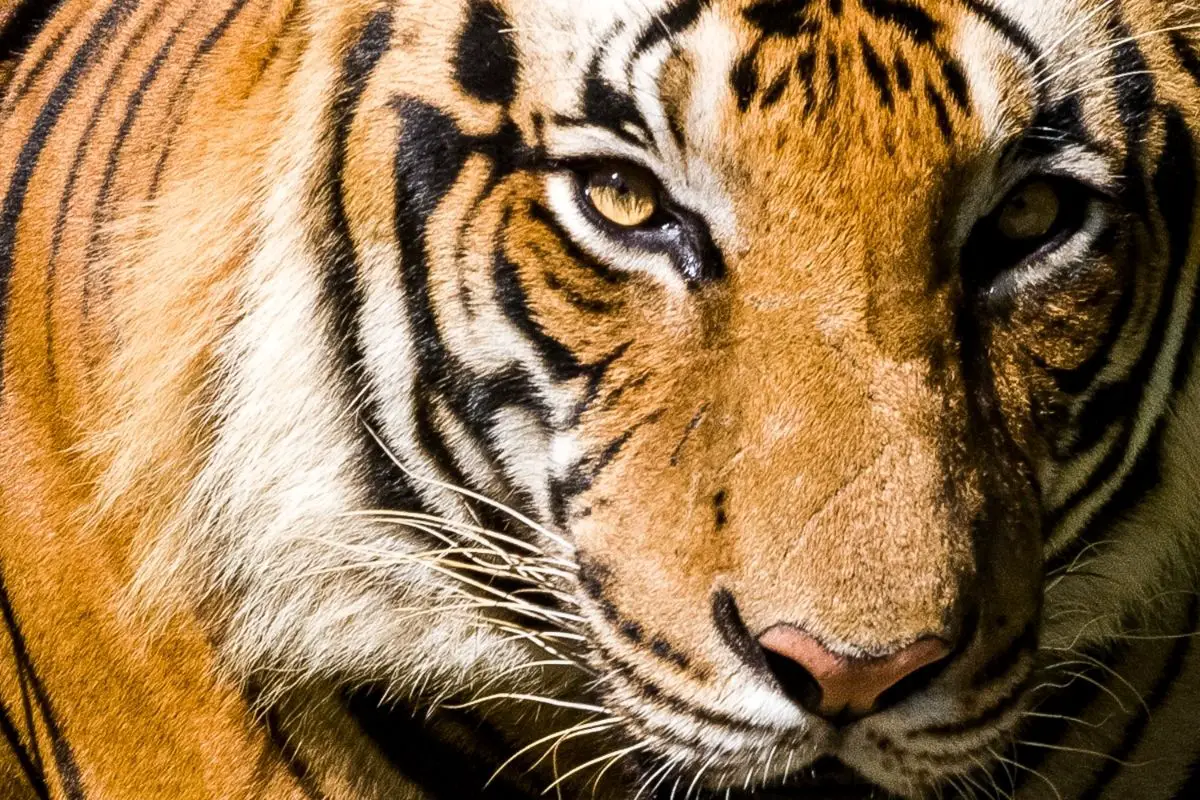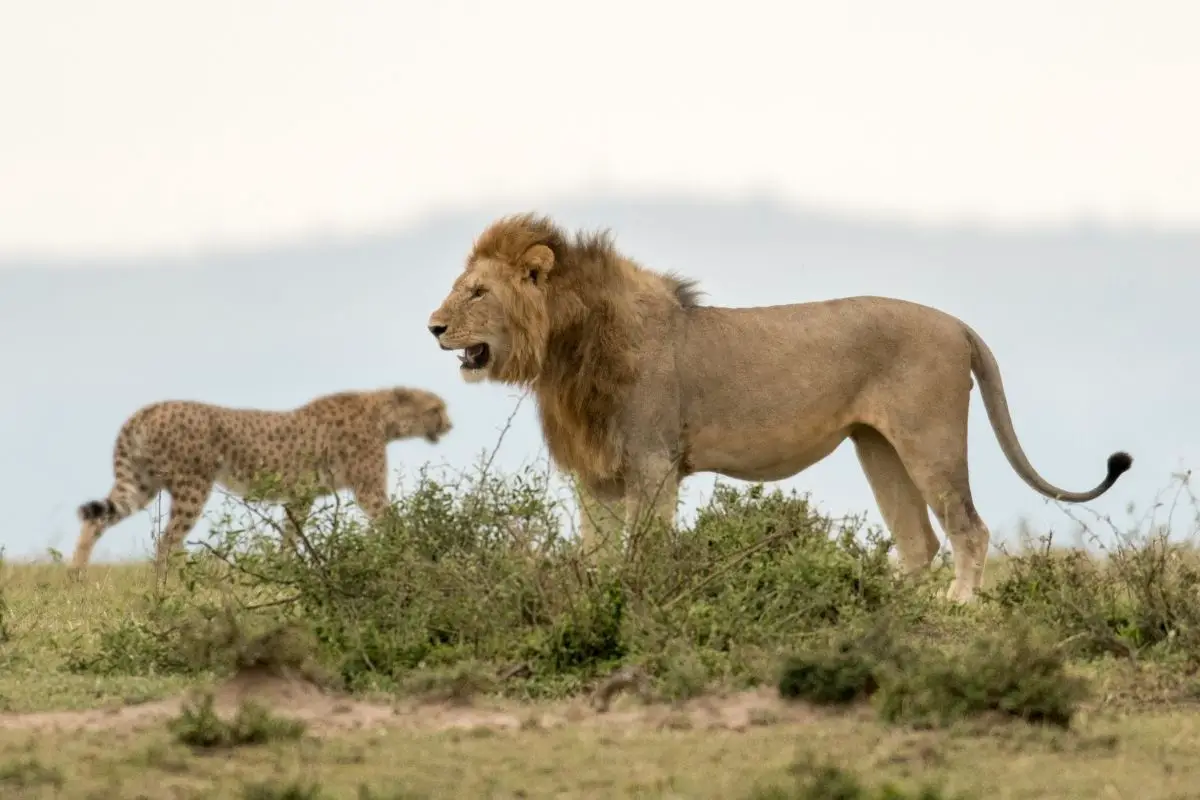The iconic title of “King of the Jungle” inspires images of powerful, deadly predators waiting in the brush to pounce on helpless prey. But which formidable feline actually deserves to wear this crown – the tiger or the lion?
These big cats possess unmatched strength and prowess in the animal kingdom that place them in a class above the rest. However, important distinctions in their physical attributes, habitats, hunting styles, and levels of agility set the tiger and lion apart in critical ways.
By closely examining the evidence, we can get to the bottom of this debate once and for all. Let the royal rumble commence!
Introducing the Contenders
Before evaluating their merits side by side, let’s set the stage with background on these iconic apex predators.
The Tiger
With nine existing subspecies, the tiger is the largest living cat species in the world. Siberian tigers can reach up to 700 pounds and 10 feet in length. No wonder tigers instill fear with their massive, muscular bodies.
Powerful jaws filled with 30 teeth make easy work of crushing prey bones. Their mottled orange and black striped coat provides ideal camouflage when hunting in foliage or shadows.
Once ranging across Asia, constant poaching and habitat destruction caused tiger populations to dwindle by over 95% in just 100 years. Thanks to conservation efforts, around 3,900 tigers exist in the wild today.
The Lion
Lions are the second largest living cat after the tiger, with males reaching 400-500 pounds on average. While not as lengthy from head to tail, lions possess a muscular build and can be taller from foot to shoulder.
Their iconic manes give males a regal appearance. But the golden fur and mane also aid in scaring adversaries and attracting mates. Females do the majority of hunting while males primarily defend territory.
African lions are highly social compared to solitary tigers. They live in large family groups called prides to help take down prey and defend young cubs. Approximately 20,000 lions remain in Africa. Their numbers have dropped by 90% due to poaching, retaliatory killings by farmers, and loss of habitat.

Habitat Domains of Lions and Tigers
Now that we know the basics on these big cat heavyweights, let’s examine their domains. The habitats lions and tigers occupy play a major role in their lifestyles and survival capabilities.
The Tiger’s Realm
Tigers primarily inhabit dense forests, jungles, mangrove swamps, and areas of dense vegetation across Asia. This landscape allows them to sneak close to prey while masking their approach.
Tigers also reside in grasslands, scrublands, and temperate forests in northern Asia. But the jungle provides their ideal cover for ambush and their vertical leaping skills. Unfortunately, deforestation continually reduces tigers’ habitat.
The Lion’s Kingdom
In contrast to tigers, lions rule over the open savannas and grassy plains of sub-Saharan Africa. The wide spaces and sparse tree coverage suits their group hunting style.
Lions will also prowl through scrub forests and thicker vegetation bordering their prides’ territories. But they eventually must return to more open landscapes where prey animals graze. Human settlement has slowly eaten away at Africa’s unspoiled savannas.
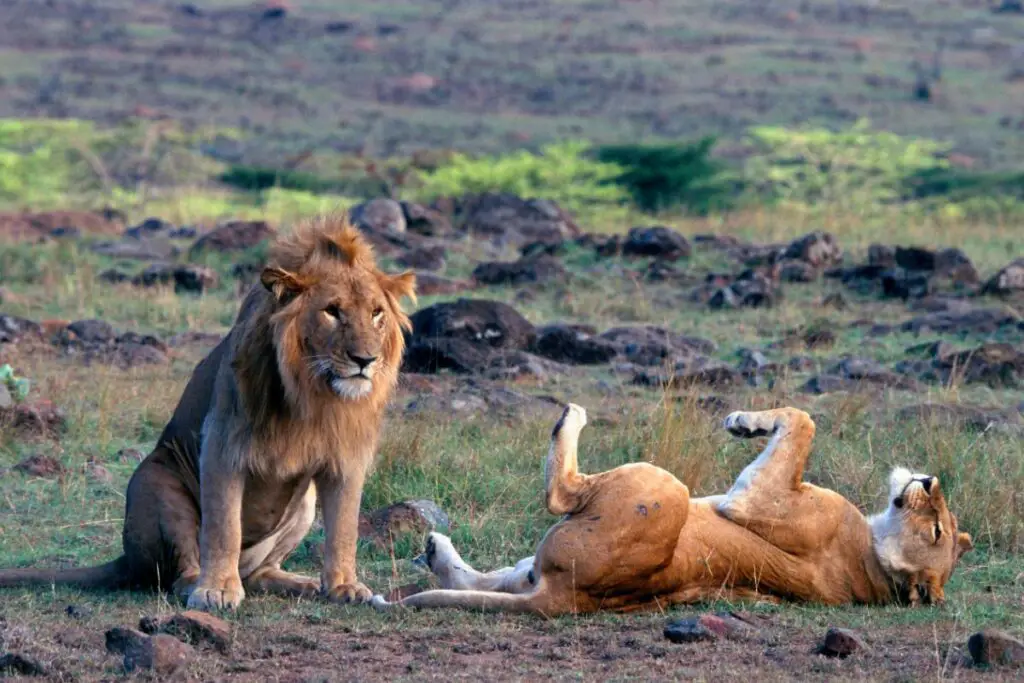
Hunting Tactics of Lions and Tigers
Habitat dictates more than just shelter and terrain. It also determines big cats’ preferred hunting strategies for catching prey. Let’s compare the tiger and lion’s distinct hunting and fighting styles.
The Stealthy Tiger
Tigers are ambush hunters relying on stealth and secrecy. Their camouflage stripes help them disappear into dense jungle vegetation. Tigers slowly stalk prey while masking their scent before pouncing from short range.
With a powerful vertical leap of over 10 feet, tigers can take down large prey by landing on their back and biting the spinal cord to paralyze them. A bite to the throat quickly suffocates victims.
Tigers prefer tackling medium to large-sized prey like deer, wild pigs, buffalo, antelope, and sometimes even bears. They drag kills to secluded areas and occasionally hoist prey into trees to protect the meal.
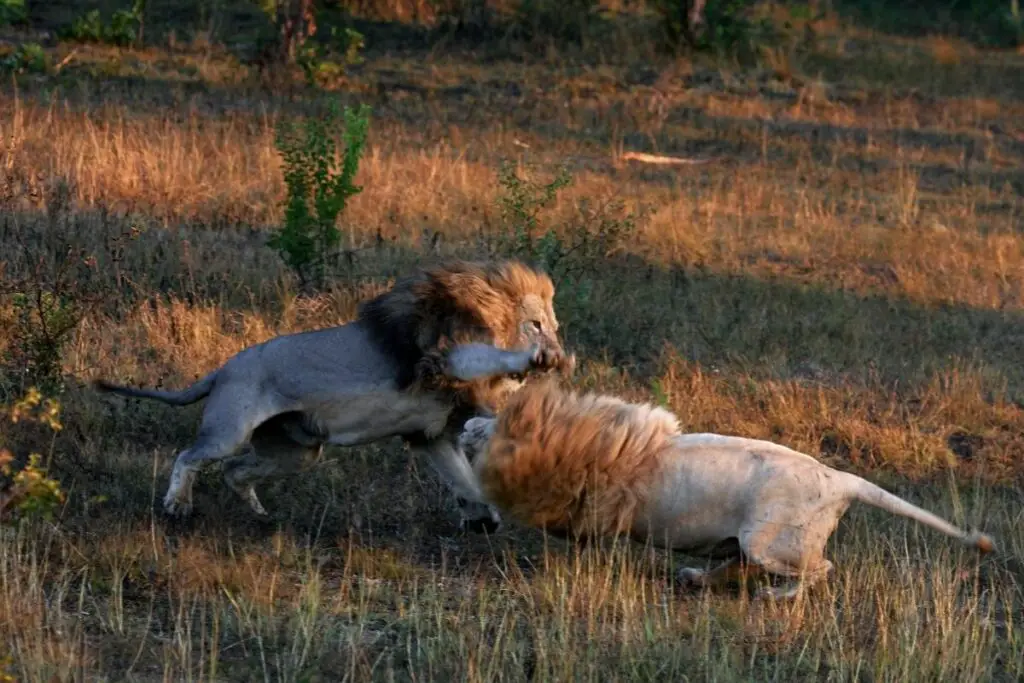
The Social Lion
In contrast to the tiger’s solitary ambush style, lions are the ultimate cooperative hunters. Female lions work together by flanking and cornering large prey like zebras, wildebeests, and buffalo.
Once prey is surrounded, lionesses go for quick powerful attacks to the hindquarters to knock the animal off balance. They finally suffocate the victim by clamping down on the throat.
Male lions play a secondary role by helping herd and isolate prey, using brawn to pull animals to the ground, and protecting kills from scavengers. But studies show lion hunts have higher success when males aren’t involved.
One-on-One Fighting Prowess of Lions and Tigers
In addition to different hunting tactics, tigers and lions have varying fighting styles worthy of comparison.
The Tiger’s Strength
When it comes to one-on-one confrontations, tigers are hard to beat. Their forelimbs wield great striking power to fend off threats. Tigers are also skilled wrestlers, using their weight and strength to pin opponents.
But their greatest weapon is a deadly suffocating neck bite. Tigers immobilize victims by biting down on the throat and holding on. Few animals can break free of a large tiger’s vice-like grip.
The Lion’s Weaponry
Lions also rely heavily on bit and choke attacks when fighting. Their powerful jaws can exert over 650 pounds of pressure to crack heavy bones.
Males have a substantial size and weight advantage over tigers that aids taking down large challengers. Lions also swipe with razor sharp 2-3 inch claws to deliver painful cuts.
But lions are disadvantaged by their lack of flexibility. Tigers can attack from any angle while lions are limited to side swipes and forward lunges. Overall, tigers possess more tools in their solo fighting arsenal.
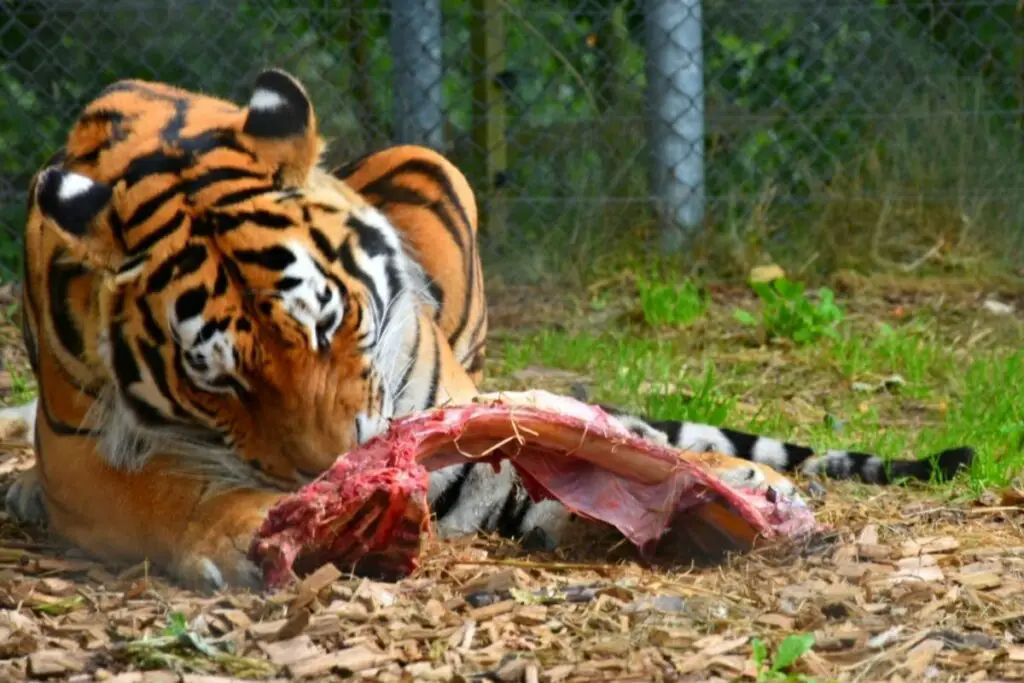
Physical Attributes Comparison of Lions and Tigers
Now that we’ve covered habitats and hunting modes, let’s break down the stats and physical differences between these brawny big cats.
Size
Tigers typically outweigh lions by a few hundred pounds. Large Siberian males can reach 700 pounds compared to the average male African lion at 420 pounds. Tigers also win in overall length at 10 feet for Siberians versus 8 feet for male lions.
However, male lions stand taller at shoulder height. Their compact muscular build gives them a strength and weight advantage in close quarters combat. But tigers have greater agility thanks to their slightly leaner frames.
Strength
When it comes to brute strength, Siberian tigers take the prize. Their massive forelimbs allow them to take down prey over twice their size, including bears and adult male buffalo.
Tigers have also been known to carry over 650 pounds of prey up trees. Lions are limited to preying on animals under 1,000 pounds and they seldom haul carcasses off the ground.
Teeth & Claws
Both cats possess deadly chompers, but tiger teeth take the cake in sheer size and pressure power. An adult tiger’s canines can reach 4 inches compared to 2.5 inches for a lion.
Tigers have pressure bites measuring over 1,000 pounds of force while lions come in around 650 psi. However, lions have much sharper retractable claws used for swatting and gripping prey. Tigers keep their claws withdrawn for stealth ambush attacks.
Senses
Lions and tigers have comparable senses of sight, smell, and hearing adapted for hunting. But lions take the edge in night vision. Their eyes have a reflective coating that harnesses light better in darkness. Tigers still fare well at night but hunt more by scent tracking prey trails.
Agility & Coordination
Tigers are unmatched in their athleticism and coordination. They can make vertical leaps of over 10 feet from a standstill and horizontally jump distances of up to 30 feet.
Their lean muscular build contributes to great flexibility for making sharp turns and grappling prey from any angle. Lions are slower and less nimble due to their stocky build.
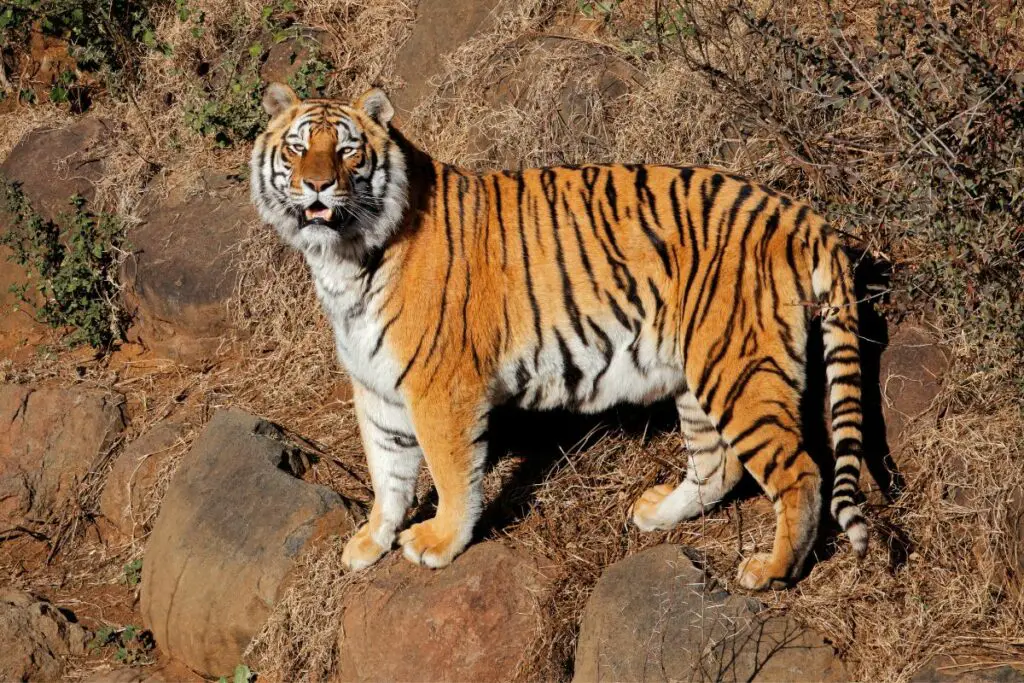
The Verdict on Size and Strength
Tigers paw their way to the top in categories of weight, overall size, brute strength, and agility. But lions come in a close second in critical measurements of height and biting force. While very close, the tiger just barely wins as the superior physical specimen.
Population and Conservation
Beyond their distinct attributes and hunting tactics, tigers and lions differ significantly in current worldwide populations and conservation status.
Tiger Numbers in Decline
Three tiger subspecies – the Caspian, Javan, and Balinese – have gone extinct over the past century. And the South China tiger has not been spotted in the wild in over 20 years, making it functionally extinct.
Habitat loss and rampant poaching for skins and body parts used in Chinese medicine have decimated global tiger numbers. Just 80 years ago, there were estimated to be over 100,000 wild tigers. Today only around 3,900 remain in scattered populations.
The International Union for Conservation of Nature (IUCN) classifies tigers as Endangered with a very high risk of extinction in the wild without further protection efforts.
Lions Slipping as Well
Lions face similar threats of prey scarcity, human-wildlife conflict, and trophy hunting across Africa. Lion populations have declined by 43% in just the past two decades.
The iconic species has already been wiped out from over 90% of their historic range. Only around 20,000 lions remain in Sub-Saharan Africa and isolated parts of India.
Lions are currently listed as Vulnerable on the IUCN Red List but are close to qualifying as Endangered. While not in as dire straits as tigers, lions require extensive conservation action to preserve the pride for future generations.
Which Big Cat Reigns Supreme?
We’ve now covered the standout attributes, habitat distinctions, hunting tactics, physical prowess, and conservation status of tigers and lions. With all the evidence in, which mighty predator has the right to call itself the true King of the Jungle?
The Tiger Stands Alone
While lions deserve immense respect, tigers prove themselves as the more capable and deadly predator in key categories. Their superior strength-to-weight ratio, unmatched killer bite force, stealthy ambush hunting mode, and greater agility give tigers the edge in one-on-one confrontations and solo hunting prowess.
The fact that tigers routinely take down prey much larger than themselves – including adult elephants, rhinos, and brown bears – demonstrates their place at the top of the food chain. Solitary tigers have never been known to attack adult male lions, only lone lionesses and cubs.
Lions may have a reputation for being “kingly” based on their stately appearance and social pride structure. But the tiger’s superior skills as a lone hunter and fighter make it the true king of the jungle. The apex predator all other residents rightfully fear and bow to.
Long Live the King
We hope this comparison served as an entertaining thought experiment settling the age-old tiger vs. lion debate. In truth, these iconic carnivores represent two sides of the same precious coin.
Both lions and tigers serve critical roles as apex predators that help regulate ecosystems. Their declining numbers disturb the natural balance and biodiversity within their environments.
These deadly hunters invoke fear and wonder in equal measure. We should make an effort to protect the few remaining havens these vulnerable “kings” call home rather than debating which deserves the throne. With targeted conservation, both lions and tigers can continue roaring proudly over their domains for centuries to come.
Lion and Tigers: Who is King of the Jungle FAQ:
Why is the lion called the king of the jungle?
The lion is often referred to as the ‘king of the jungle’ because of its majestic appearance and position as a top predator. The male lion, with its impressive mane, is often associated with strength, courage, and dominance, traits that are traditionally associated with kingship.
Are tigers found in the jungle?
Yes, tigers are found in various habitats, including jungles, grasslands, and deciduous forests. The term ‘jungle’ is often used in a broad sense to refer to any wild, dense, forested area, and tigers can be found in such areas across Asia.
Which is bigger, a lion or a tiger?
Tigers are generally larger and heavier than lions. A male Siberian tiger, the largest subspecies of tiger, can weigh up to 660 pounds and measure up to 12 feet in length, including the tail. In contrast, a male African lion typically weighs between 330 to 550 pounds and measures 8 to 10 feet in length, including the tail.
Who would win in a fight, a lion or a tiger?
It is difficult to say definitively who would win in a fight between a lion and a tiger, as it would depend on various factors such as the size, age, and health of the individuals involved. However, tigers are generally larger and stronger than lions, and have been known to win fights against lions in captivity. It is important to note that such fights are unnatural and cruel, and in the wild, lions and tigers have different habitats and rarely, if ever, encounter each other.
If the tiger is bigger and stronger, why is the lion considered the king of the jungle?
The title ‘king of the jungle’ is more of a cultural designation than a biological one. Lions have been associated with kingship in various cultures for thousands of years, and this association has been reinforced through art, literature, and folklore. The lion’s mane, which is unique among big cats, gives it a regal appearance that has contributed to its reputation as the ‘king of the jungle’. Additionally, lions are the only big cats that live in social groups, called prides, and the male lion’s role as the protector of the pride has contributed to its kingly reputation.
- Sink Your Teeth Into This: Analyzing the Powerful Lion Bite Force - September 8, 2023
- Siberian Tigers: Everything You Need To Know - September 4, 2023
- Do Lions Eat Humans? Understanding Lion Aggression and Risks - September 4, 2023

